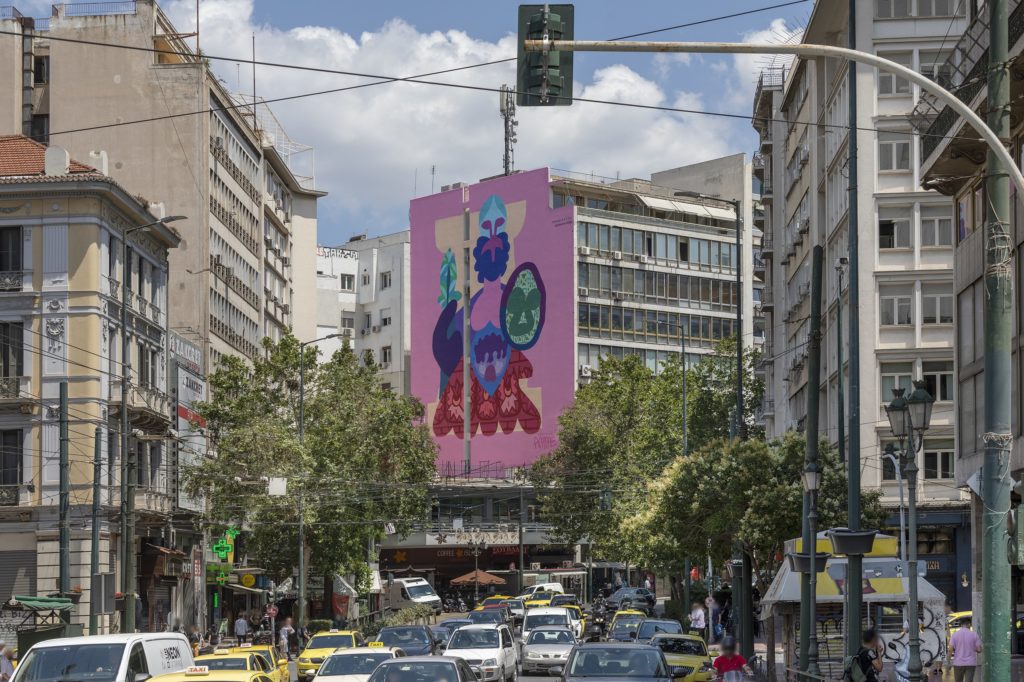Aristeidis Lappas
"She Who Protects" mural by Aristeidis Lappas | Onassis Stegi
June 16, 2022–June 16, 2022Omonoia Square, Athens
Aristeidis Lappas’ mural, entitled “She Who Protects” and situated close to Omonia Square (58, Panepistimiou Street), is a tribute to diversity, highlighting the vibrant character of an ever-changing city. It is a work that reflects the colorful character of Athens and the diverse cultural background of contemporary Athenians.
In conversation with the statue of Athena Promachos by Leonidas Drosis, as well as that of Phidias, the Athena of Lappas emerges as the protector of the city of Athens. The goddess is rendered fully armored, holding her spear and shield. She has descended from her high pedestal and is preparing to become one with the crowd. Though a commanding presence, she is not overwhelming and will not scare the unsuspecting and usually hurried passers-by. The untethered forms and bright colors of the composition suggest a kids’ drawing, while the patterns on her armor allude to African fabrics and traditional women’s costumes from the Balkans. The colorful goddess of Lappas reflects the nomadic culture and the multiculturalism we encounter in the neighborhoods of the Athenian center. The artist thus adapts a mythological narrative to the conditions of our time. On another level, already aware that ancient statues were colorful and part of everyday life, Lappas repeats a question that seems to have intrigued him for a long time now: What role does color play in sculpture?
The artist notes on his mural: “This work is in a dialogue with an image from a large banner that was hanging from the building of a department store at Omonia Square. It was an image that aspired to communicate the character of the city to the public. To the people who were passing every day in front of it, but to those as well who were coming from afar to meet it. It was an image of the goddess Athena on the Ionian column, meaning the statue by Leonidas Drosis, which was standing high at the Academy of Athens, a few meters away from the square. With the banner now removed, this white statue still remains the image that gives our city its name. An image based on a prototype chosen to define us. But right there, at the bottom of the column, there is another goddess, one that gives this city its character. The spirit that exists in the city’s narrow streets, its bars and its arcades, the air that fills its lungs with heat.
Doing a research on ancient goddesses, I discovered that Athena’s roots go deep back into history. Different versions and expressions of the very same mythological idea are found in several places, such as Neolithic Europe, Egypt, and Mesopotamia. Likewise, references to birds of prey related to the Great Female Goddess of prehistoric matriarchal communities, such as the owl, which we know now as a symbol of wisdom. The snakes on her clothes, noticed now only by a few, are symbols of change and rebirth. The mermaid on her armor is a reminder of her primordial power to anyone who goes to confront her. Therefore, these references began to formulate a colorful aspect of this known to all goddess, who sees us every day passing furiously though the center of her city.
It is now widely known that most of the statues of antiquity were colored and our Western perception of them as a white ideal has perhaps more readings than the one we know. Seeing Athena as a symbol enriched by references and links to stories from different civilizations brings her perhaps closer to Athens as it is nowadays. A city inhabited by people coming from all corners of the world, a city belonging to them. This Athens is dressed in colorful clothes from the East, Africa, and the Balkan villages, places where its mythological idea stems from.
Maybe within our History lay all the elements to build a narrative that will fit all people, as long as we can imagine it and recite it. With this work, I tried to depict an Athena, who represents, cares for, and protects Athens as it is now. A city of many stories, colors and dreams.”

